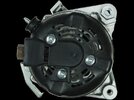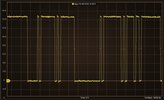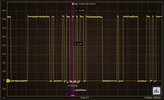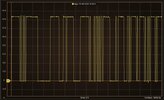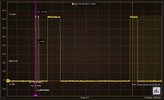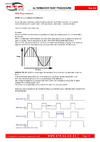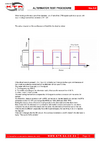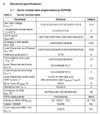I have purchased a second alternator, custom H/O alternator.
It runs great. 270A, looks to be a housing used in many Toyotas.
Internal Voltage Regulator has a 4-pin square plug.
I cant seem to identify my regulator or find datasheets.
I want to build a arduino interface to sense the load.
the plug has 4 pins: [Ignition - Lamp - Voltage sense - Unknown]
This Unknown pin should be one of the following depending on the regulator he fitted:
DFM / FR: Field Monitor, block pulse signal indicating alternator load
COM: bi-direction communication to ECU probably LIN-2 19K2
On my setup this pin is floating currently, its not needed for the alternator to function and my car doesn't have an ECU(yes really).
When I hook up my o-scope to this pin I just get a steady 0V.
No signal at all when I switch on or off or load the alternator nothing... just a touch of noise.
I'm thinking ok maybe its LIN Bus as it would be silent with no master querying the bus.
Reading up on LIN Bus it says that it is high dominant so I was expecting a 12V pull-up. now I'm confused.
Can anyone give me some tips on identifying this 4th pin on my harness ?
Is it possible that LIN Bus slaves keep the line low when no master is on the bus ?
Any info or suggestions at all will be greatly appreciated
Attached are some images of what looks to be an identical alternator to mine.
It runs great. 270A, looks to be a housing used in many Toyotas.
Internal Voltage Regulator has a 4-pin square plug.
I cant seem to identify my regulator or find datasheets.
I want to build a arduino interface to sense the load.
the plug has 4 pins: [Ignition - Lamp - Voltage sense - Unknown]
This Unknown pin should be one of the following depending on the regulator he fitted:
DFM / FR: Field Monitor, block pulse signal indicating alternator load
COM: bi-direction communication to ECU probably LIN-2 19K2
On my setup this pin is floating currently, its not needed for the alternator to function and my car doesn't have an ECU(yes really).
When I hook up my o-scope to this pin I just get a steady 0V.
No signal at all when I switch on or off or load the alternator nothing... just a touch of noise.
I'm thinking ok maybe its LIN Bus as it would be silent with no master querying the bus.
Reading up on LIN Bus it says that it is high dominant so I was expecting a 12V pull-up. now I'm confused.
Can anyone give me some tips on identifying this 4th pin on my harness ?
Is it possible that LIN Bus slaves keep the line low when no master is on the bus ?
Any info or suggestions at all will be greatly appreciated
Attached are some images of what looks to be an identical alternator to mine.
Attachments
Last edited:


